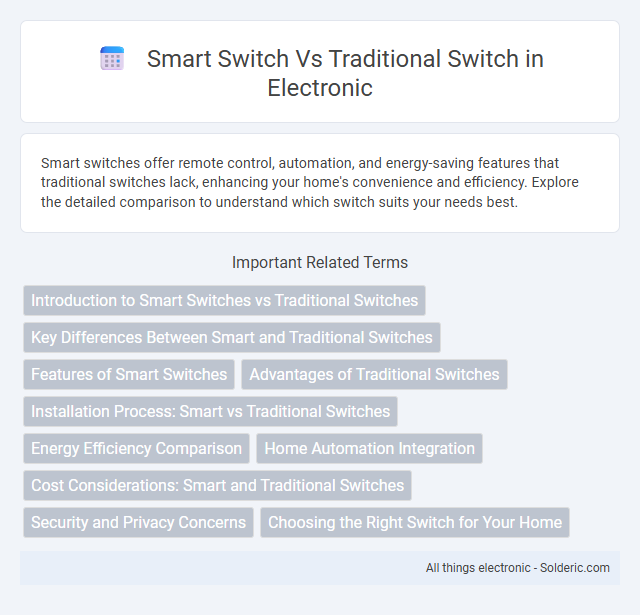Smart switches offer remote control, automation, and energy-saving features that traditional switches lack, enhancing your home's convenience and efficiency. Explore the detailed comparison to understand which switch suits your needs best.
Comparison Table
| Feature | Smart Switch | Traditional Switch |
|---|---|---|
| Control | Remote via app, voice control | Manual on/off only |
| Connectivity | Wi-Fi, Zigbee, Z-Wave | Wired electrical connection |
| Installation | Requires neutral wire, setup via app | Simple wiring, no setup needed |
| Automation | Schedules, scenes, integrations | No automation support |
| Energy Monitoring | Available in some models | Not available |
| Cost | Higher upfront cost | Lower cost |
| Compatibility | Compatible with smart home systems | Only controls lighting/fans |
Introduction to Smart Switches vs Traditional Switches
Smart switches offer advanced features such as remote control, energy monitoring, and automation compared to traditional switches that provide only basic on/off functionality. These devices integrate with home automation systems via Wi-Fi or Zigbee, enabling seamless control through smartphones or voice commands. Traditional switches remain limited to manual operation and lack connectivity options, making smart switches more suitable for modern, connected environments.
Key Differences Between Smart and Traditional Switches
Smart switches offer advanced features such as remote control, automation, and integration with smart home systems, unlike traditional switches that provide simple on/off functionality. The key differences include connectivity options, user control via apps or voice assistants, and enhanced energy management capabilities. Your choice depends on whether you need basic manual operation or sophisticated control and monitoring for your lighting system.
Features of Smart Switches
Smart switches offer advanced features such as remote control via smartphone apps, scheduling options, and integration with home automation systems like Alexa or Google Assistant. These switches often include energy monitoring, dimming capabilities, and customizable settings to enhance convenience and efficiency. Your home benefits from increased control and smart functionality that traditional switches cannot provide.
Advantages of Traditional Switches
Traditional switches offer simplicity and reliability with straightforward installation and minimal configuration requirements. They provide cost-effective network connectivity suitable for small-scale or basic networking needs without the complexity of advanced management features. Your network benefits from reduced maintenance efforts and lower initial investment when opting for traditional switches.
Installation Process: Smart vs Traditional Switches
The installation process for traditional switches is straightforward, involving basic wiring and no configuration, making it suitable for quick setup. Smart switches require a more detailed installation, including wiring compatible with the home network and configuring via an app or hub for functionality like remote control and automation. Compatibility with existing electrical systems and the need for a neutral wire often make smart switch installation more complex compared to traditional switches.
Energy Efficiency Comparison
Smart switches optimize energy consumption by allowing you to control lighting remotely and set schedules, reducing unnecessary power usage compared to traditional switches that rely on manual operation. Traditional switches often leave lights on unintentionally, whereas smart switches integrate with sensors and automation to turn off devices automatically, enhancing overall energy efficiency. Choosing a smart switch can lead to significant energy savings and lower utility bills through intelligent management of your electrical devices.
Home Automation Integration
Smart switches enable seamless home automation integration by allowing you to control lighting and appliances remotely via smartphone apps, voice assistants, or automation routines. Unlike traditional switches that require manual operation, smart switches can be programmed to respond to schedules, triggers, and sensors, enhancing convenience and energy efficiency. Your home's connectivity is significantly improved with smart switches, forming the backbone of a modern automated ecosystem.
Cost Considerations: Smart and Traditional Switches
Smart switches generally involve higher upfront costs due to advanced technology and integration features, while traditional switches are more affordable and straightforward. However, smart switches can offer long-term savings through energy efficiency and remote control capabilities that reduce electricity use. Your choice should weigh initial expenses against potential energy savings and convenience benefits.
Security and Privacy Concerns
Smart switches incorporate advanced encryption protocols and user authentication features to ensure secure remote access and prevent unauthorized control, significantly enhancing privacy compared to traditional switches. Traditional switches lack network connectivity, reducing exposure to cyber threats but also limiting control to physical interaction without remote monitoring capabilities. Emerging security risks in smart switches include vulnerabilities to hacking and data interception, necessitating regular firmware updates and robust security practices to safeguard user information and device integrity.
Choosing the Right Switch for Your Home
Smart switches offer advanced control features such as remote access, scheduling, and integration with home automation systems, enhancing convenience and energy efficiency. Traditional switches are simpler, more affordable, and require no additional setup, making them suitable for basic lighting needs. Evaluating your home's automation goals and budget helps determine whether a smart or traditional switch best fits your lifestyle.
smart switch vs traditional switch Infographic

 solderic.com
solderic.com